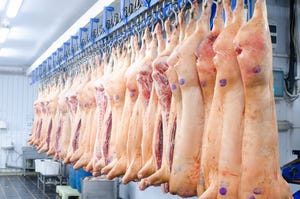New Swine Genome Technology to Guide Future Selection Methods
New genotyping technology could provide improvements over traditional selection methods. Recent advances in swine genomics have led to faster and cheaper methods of genotyping, making it easier to learn more about each pig's genetic makeup. This new method, the porcine 60K SNP chip, allows users to collect genotypes at 64,232 genetic markers in a pig, simultaneously. Developed with the help of researchers
February 15, 2010

New genotyping technology could provide improvements over traditional selection methods.
Recent advances in swine genomics have led to faster and cheaper methods of genotyping, making it easier to learn more about each pig's genetic makeup.
This new method, the porcine 60K SNP chip, allows users to collect genotypes at 64,232 genetic markers in a pig, simultaneously. Developed with the help of researchers from many laboratories, including Iowa State University, this new method offers extremely high accuracy and costs approximately 0.3 cents per genotype.
Researchers have used this new method to look for genes associated with a variety of traits, and have a goal of using that knowledge to decrease production costs by several dollars per pig in the near future.
The first trait examined was residual feed intake (RFI) — the difference between how much feed a pig consumes and how much it should need to consume based on its growth and maintenance needs. Selecting for improved RFI should reduce feed costs without sacrificing growth rates.
Traits associated with growth rate and meat quality, such as average daily gain, average daily feed intake, backfat, loin muscle area and intramuscular fat have also been examined. Genes previously known to be associated with these traits, such as MC4R gene, were verified and new genes were discovered in the swine genome projects.
One of the major costs for a breeding herd is purchasing or producing replacement gilts. If better genetics can improve the productive lifetime of females brought into the breeding herd, then replacement costs will be reduced, older sows will provide higher antibody levels to piglets for greater immunity to disease, and sow culling/mortality levels will be reduced.
The capability of improving traits, such as number born alive, total number born, gestation length, reducing the number of stillborns and mummies and, hopefully, increasing the number of piglets born alive per litter will improve breeding herd productivity.
It is widely accepted that reproductive and feet and leg structural traits have a large impact on sow culling and mortality rates. Researchers have found genes associated with leg action and specific leg conformation traits that could be used to improve leg structure.
Overall, the new genotyping technology should soon have a positive impact on a variety of traits that are difficult to improve using traditional selection methods. Over the next five years, genotyping should move from small sets of genetic markers to thousands of markers for more traits.
Researchers: Max F. Rothschild, Danielle M. Gorbach, Bin Fan, Suneel K. Onteru, Zhi-Qiang Du, Jack C.M. Dekkers, Kenneth Stalder, Dorian Garrick and Rohan Fernando; contact Rothschild by phone (515) 294-6202 or e-mail [email protected].
You May Also Like
.png?width=300&auto=webp&quality=80&disable=upscale)


